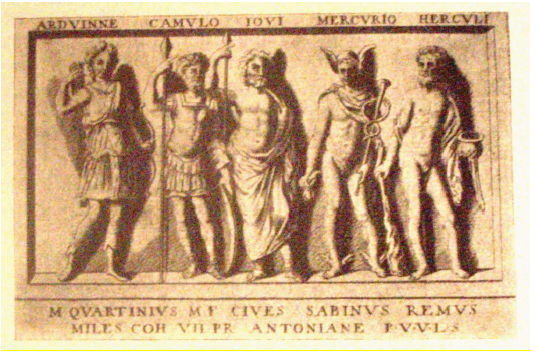C) Goddesses of ‘High Places’
1) Arduinna (‘the High One’)
a) Inscriptions
The goddess name Arduinna is known from an inscription discovered on the road from Düren to Montjoye, near Gey (Germany): Deae Ardbinnae T(itus) Iulius Aequalis [v]slm, ‘To the goddess Arduinna, T. Julius Equalis paid his vow willingly and deservedly’.1118 Spickermann explains thatthe letter b accounts for the letter u. Ardbinna must be a presumably regional variant of Arduinna.1119 Arduinna is generally said to be honoured with the Celtic god Camulus and the three Roman deities Jupiter, Mercury and Hercules in a dedication from Rome engraved under a relief* representing the five deities: Arduinne, Camulo, Iovi, Mercurio, Herculi, M(arcus) Quartinius M(arci) f(ilius) cives Sabinus Remus, miles coh(ortis) VII pr(aetoriae) Antoniniane p(iae) v(indicis) v(otum) l(ibens) s(olvit) (fig. 49).1120 In this now lost figuration,Camulus (‘Champion’ or ‘Servant’) is unsurprisingly depicted as the Roman god of war, for he is generally associated with Mars in the inscriptions.1121 As for Arduinna, she is portrayed in the features of Diana with a bow and a quiver. Despite its relatively puzzling character, the authenticity of this document had never been questioned or contested until Claude Sterckx pointed out that it was actually a fanciful reconstitution of a relief*, which originally depicted Saturnus and Mars instead of Arduinne and Camulus.1122 Therefore, this document does not mention Arduinna and her representation as a Roman Diana is erroneous.

A third fragment of inscription, engraved on a silver dish from La Rocque d’Anthéron (Bouches-du-Rhône), could allude to Arduinna: …]tialniarduinn[…, but the reading remains uncertain and hypothetical.1123Only one dedication thus mentions the goddess Arduinna, that is the inscription from Düren.